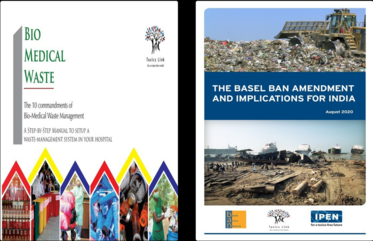
Title: An Insight of Mercury-Free Products in India
Publication Type: Research Reports
Year of Publication: 2021
Abstract:This study is an indication on the overall status of the mercury-free alternative products in India. It was found that in some of the sectors like health care and lamps, India has made considerable progress in shifting to the alternative products. However, the cost and quality of the products are the major concerns for India considering the wide diversity of the socio-economic class of people living in the country. Further information on the health hazards of mercury is low among the consumers, traders, manufacturers and the workers as well.Another important aspect of the study is that the domestic demand for mercury and mercury-free products are largely met with the import from China. Incidentally the study also reflected that with the ban on export of mercury products from China, business is getting affected particularly of health care instruments like thermometer and sphygmomanometer. Nevertheless, there are industries which are manufacturing mercury-free products in India and with suitable policy and government handholding India can become a manufacturing hub for the mercury-free products. Therefore, it’s the right time for the government to assess the current scenario and act accordingly to make it a mercury-free country and also emerge as a manufacturing hub for mercury-free products.
Suggested Readings
Microplastics in Cosmetics
In the study, 6 face wash, 3 body washes, 3 face scrubs from different brands, 1 face mask and 5 varieties of leave-on lotions were analysed for detecting the presence of microplastics (water insoluble) of more than 0.45 micron size. Large numbers of particles, especially granular material were observed with naked eye. Stereomicroscopic examination as well as filtration indicated presence of micro particles in 9 out of the 18 samples tested. The findings indicated presence of microplastics in most of the rinse off cosmetics. Interestingly, none of the leave-on products were detected with microplastics or even microparticles. Presence of insoluble micro particles in majority of the rinse off products does raise an alarm. These are designed to be disposed of with no possibility of recovery or recycling. Out of the 12 rinse off products included in the study, 5 of them were found to have microplastic. Since these are direct body to drain products, the beads from these products get directly into the water system and through the water channel reach the larger water bodies.
Endocrine Disruptor: Review of Indian Research
EDCs are widely used in the consumer products and researchers claim their human and environmental health impacts through their wide research. Some of the Indian researchers tried to show the direct relationships between these EDCs and animal, environmental impact in their experiments but were not able to produce much information on human health. But the research data from various international sources proved that these EDCs have acute health impacts on human health too. Further research in Indian context can support this. It is also observed that in some cases there are no standards or regulation in place; hence there has no control or restriction of its use in consumer products so it leads to the downstream contamination. The document has tried to bring out the current scenario in Indian context regarding some of the EDCs.
Cleaning Clothes? A Study on the Chemical Solvent PERC Used in Dry-Cleaning
Dry-cleaning is a popular service used in most parts of India, especially urban areas. It is often used for cleaning expensive and sensitive clothing. With changing lifestyles in urban India, this service is only going to grow in the future. Though currently many solvents are being used in the dry-cleaning facilities in India, PERC is a key one. Inspite of PERC being globally considered a toxic chemical, there has been very limited research on understanding its impact on health and environment in the Indian context.This study aims to bridge some of these gaps by understanding and documenting the current usage of PERC in the dry-cleaning industry. It also looks at issues of workers’ safety and disposal practices for this chemical in the industry, as it is known to be an occupational hazard. Apart from this, the study investigates the possibility of PERC risks for consumers who use dry-cleaned clothes.













